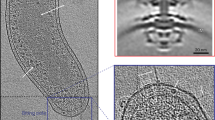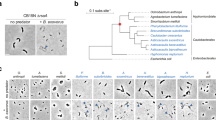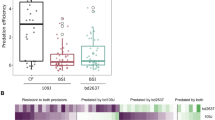Abstract
Bdellovibrio and like organisms (BALO) are obligate predators of Gram-negative bacteria, belonging to the α- and δ-proteobacteria. BALO prey using either a periplasmic or an epibiotic predatory strategy, but the genetic background underlying these phenotypes is not known. Here we compare the epibiotic Bdellovibrio exovorus and Micavibrio aeruginosavorus to the periplasmic B. bacteriovorus and Bacteriovorax marinus. Electron microscopy showed that M. aeruginosavorus, but not B. exovorus, can attach to prey cells in a non-polar manner through its longitudinal side. Both these predators were resistant to a surprisingly high number of antibiotic compounds, possibly via 26 and 19 antibiotic-resistance genes, respectively, most of them encoding efflux pumps. Comparative genomic analysis of all the BALOs revealed that epibiotic predators have a much smaller genome (ca. 2.5 Mbp) than the periplasmic predators (ca. 3.5 Mbp). Additionally, periplasmic predators have, on average, 888 more proteins, at least 60% more peptidases, and one more rRNA operon. Fifteen and 219 protein families were specific to the epibiotic and the periplasmic predators, respectively, the latter clearly forming the core of the periplasmic ‘predatome’, which is upregulated during the growth phase. Metabolic deficiencies of epibiotic genomes include the synthesis of inosine, riboflavin, vitamin B6 and the siderophore aerobactin. The phylogeny of the epibiotic predators suggests that they evolved by convergent evolution, with M. aeruginosavorus originating from a non-predatory ancestor while B. exovorus evolved from periplasmic predators by gene loss.
Similar content being viewed by others
Log in or create a free account to read this content
Gain free access to this article, as well as selected content from this journal and more on nature.com
or
References
Abram D, Melo CJ, Chou D . (1974). Penetration of Bdellovibrio bacteriovorus into host cells. J Bacteriol 118: 663–680.
Alami M, Lüke I, Deitermann S, Eisner G, Koch H-G, Brunner J et al (2003). Differential interactions between a twin-arginine signal peptide and its translocase in Escherichia coli. Mol Cell 12: 937–946.
Altschul SF, Madden TL, Schaffer AA, Zhang J, Zhang Z, Miller W et al (1997). Gapped BLAST and PSI-BLAST: a new generation of protein database search programs. Nucleic Acids Res 25: 3389–3402.
Alves JMP, Buck GA . (2007). Automated system for gene annotation and metabolic pathway reconstruction using general sequence databases. Chem Biodiv 4: 2593–2602.
Barel G, Jurkevitch E . (2001). Analysis of phenotypic diversity among host-independent mutants of Bdellovibrio bacteriovorus 109J. Arch Microbiol 176: 211–216.
Barel G, Sirota A, Volpin H, Jurkevitch E . (2005). Fate of predator and prey proteins during browth of Bdellovibrio bacteriovorus on Escherichia coli and Pseudomonas syringae prey. J Bacteriol 187: 329–335.
Campbell AP, Wong WY, Houston Jr M, Schweizer F, Cachia PJ, Irvin RT et al (1997). Interaction of the receptor binding domains of Pseudomonas aeruginosa pili strains PAK, PAO, KB7 and P1 to a cross-reactive antibody and receptor analog: implications for synthetic vaccine design. J Mol Biol 267: 382–402.
Carver TJ, Rutherford KM, Berriman M, Rajandream M-A, Barrell BG, Parkhill J . (2005). ACT: the Artemis comparison tool. Bioinformatics 21: 3422–3423.
Cotter T, Thomashow M . (1992). Identification of a Bdellovibrio bacteriovorus genetic locus, hit, associated with the host-independent phenotype. J Bacteriol 174: 6018–6024.
Crossman LC, Chen H, Cerdeno-Tarraga A-M, Brooks K, Quail MA, Pineiro SA et al (2013). A small predatory core genome in the divergent marine Bacteriovorax marinus SJ and the terrestrial Bdellovibrio bacteriovorus. ISME J 7: 148–160.
Dashiff A, Kadouri D . (2009). A new method for isolating host-independent variants of Bdellovibrio bacteriovorus using E. coli auxotrophs. Op Microbiol J 3: 87–91.
Davidov Y, Huchon D, Koval SF, Jurkevitch E . (2006). A new α-proteobacterial clade of Bdellovibrio-like predators: implications for the mitochondrial endosymbiotic theory. Environ Microbiol 8: 2179–2188.
Depuydt M, Leonard SE, Vertommen D, Denoncin K, Morsomme P, Wahni K et al (2009). A periplasmic reducing system protects single cysteine residues from oxidation. Science 326: 1109–1111.
Dori-Bachash M, Dassa B, Pietrokovski S, Jurkevitch E . (2008). Proteome-based comparative analyses of growth stages reveal new cell cycle-dependent functions in the predatory bacterium Bdellovibrio bacteriovorus. Appl Environ Microbiol 74: 7152–7162.
Dridi B, Fardeau M-L, Ollivier B, Raoult D, Drancourt M . (2011). The antimicrobial resistance pattern of cultured human methanogens reflects the unique phylogenetic position of archaea. J Antimicrob Chemo 66: 2038–2044.
Eddy SR . (1998). Profile hidden Markov models. Bioinformatics 14: 755–763.
Evans KJ, Lambert C, Sockett RE . (2007). Predation by Bdellovibrio bacteriovorus HD100 requires Type IV pili. J Bacteriol 189: 4850–4859.
Fenton AK, Kanna M, Woods RD, Aizawa SI, Sockett RE . (2010b). Shadowing the actions of a predator: backlit fluorescent microscopy reveals synchronous nonbinary septation of predatory Bdellovibrio inside prey and exit through discrete bdelloplast pores. J Bacteriol 192: 6329–6335.
Fenton AK, Lambert C, Wagstaff PC, Sockett RE . (2010a). Manipulating each MreB of Bdellovibrio bacteriovorus gives diverse morphological and predatory phenotypes. J Bacteriol 192: 1299–1311.
Forterre P, Gribaldo S, Gadelle D, Serre M-C . (2007). Origin and evolution of DNA topoisomerases. Biochimie 89: 427–446.
Gohlke U, Pullan L, McDevitt CA, Porcelli I, de Leeuw E, Palmer T et al (2005). The TatA component of the twin-arginine protein transport system forms channel complexes of variable diameter. Proc Natl Acad USA 102: 10482–10486.
Grissa I, Vergnaud G, Pourcel C . (2007). CRISPRFinder: a web tool to identify clustered regularly interspaced short palindromic repeats. Nucleic Acids Res 35: W52–W57.
Gruber TM, Gross CA . (2003). Multiple Sigma subunits and the partitioning of bacterial transcription space. Ann Rev Microbiol 57: 441–466.
Hansen JK, Forest KT . (2006). Type IV Pilin structures: insights on shared architecture, fiber assembly, receptor binding and Type II secretion. J Mol Microbiol Biotechnol 11: 192–207.
Hobley L, Fung R, Lambert C, Harris M, Dabhi J, King S et al (2012). Discrete cyclic di-GMP-dependent control of bacterial predation versus axenic growth in Bdellovibrio bacteriovorus. PLoS Pathog 8: e1002493.
Hyatt D, Chen G-L, LoCascio P, Land M, Larimer F, Hauser L . (2010). Prodigal: prokaryotic gene recognition and translation initiation site identification. BMC Bioinformatics 11: 119.
Jurkevitch E . (2005) Isolation and Classification of Bdellovibrio and Like Organisms. Current Protocols in Microbiology. John Wiley & Sons, Inc.
Jurkevitch E, Davidov Y . (2007). Phylogenetic Diversity and Evolution of Predatory Prokaryotes. In: Jurkevitch E (ed) Predatory Prokaryotes – Biology, ecology, and evolution. Springer-Verlag: Heidelberg.
Jurkevitch E, Hadar Y, Chen Y . (1992). Differential siderophore utilization and iron uptake by soil and rhizosphere bacteria. Appl Environ Microbiol 58: 119–124.
Karunker I, Rotem O, Dori-Bachash M, Jurkevitch E, Sorek R . (2013). A global transcriptional switch between the attack and growth forms of Bdellovibrio bacteriovorus. PloS One 8: e61850.
Kessel M, Shilo M . (1976). Relationship of Bdellovibrio elongation and fission to host cell size. J Bacteriol 128: 477–480.
Kidd SP . (2011). Novel regulation in response to host-generated stresses: the MerR family of regulators in pathogenic bacteria. In: Kidd SP (ed) Stress Response in Pathogenic Bacteria. CABI: Cambridge, USA.
Klasson L, Andersson SGE . (2004). Evolution of minimal-gene-sets in host-dependent bacteria. Trends Microbiol 12: 37–43.
Koronakis V, Eswaran J, Hughes C . (2004). Structure and function of TolC: the bacterial exit duct for proteins and drugs. Ann Rev Biochem 73: 467–489.
Koval SF, Hynes SH, Flannagan RS, Pasternak Z, Davidov Y, Jurkevitch E . (2012). Bdellovibrio exovorus sp. nov., a novel predator of Caulobacter crescentus. Int J Syst Evol Microbiol 63: 146–151.
Lagesen K, Hallin P, Rodland E, Staerfeldt H, Rognes T, Ussery D . (2007). RNAmmer: consistent and rapid annotation of ribosomal RNA genes. Nucleic Acids Res 35: 3100–3108.
Lambert C, Chang CY, Capeness MJ, Sockett RE . (2010). The first bite—profiling the predatosome in the bacterial pathogen Bdellovibrio. PLoS One 5: e8599.
Langille MGI, Brinkman FSL . (2009). IslandViewer: an integrated interface for computational identification and visualization of genomic islands. Bioinformatics 25: 664–665.
Lerner TR, Lovering AL, Bui NK, Uchida K, Aizawa S-I, Vollmer W et al (2012). Specialized peptidoglycan hydrolases sculpt the intra-bacterial niche of predatory Bdellovibrio and increase population fitness. PLoS Pathog 8: e1002524.
Lewis K . (2010). Persister cells. Ann Rev Microbiol 64: 357–372.
Lima-Mendez G, Van Helden J, Toussaint A, Leplae R . (2008). Prophinder: a computational tool for prophage prediction in prokaryotic genomes. Bioinformatics 24: 863–865.
Lowe T, Eddy S . (1997). tRNAscan-SE: a program for improved detection of transfer RNA genes in genomic sequence. Nucleic Acids Res 25: 955–964.
Mahmoud KK, Koval SF . (2010). Characterization of type IV pili in the life cycle of the predator bacterium Bdellovibrio. Microbiology 156: 1040–1051.
Marchler-Bauer A, Lu S, Anderson JB, Chitsaz F, Derbyshire MK, DeWeese-Scott C et al (2011). CDD: a Conserved Domain Database for the functional annotation of proteins. Nucleic Acids Res 39: D225–D229.
Moran NA . (1996). Accelerated evolution and Muller’s rachet in endosymbiotic bacteria. Proc Natl Acad Sci USA 93: 2873–2878.
Moriya Y, Itoh M, Okuda S, Yoshizawa AC, Kanehisa M . (2007). KAAS: an automatic genome annotation and pathway reconstruction server. Nucleic Acids Res 35: W182–W185.
Möll A, Thanbichler M . (2009). FtsN-like proteins are conserved components of the cell division machinery in proteobacteria. Mol Microbiol 72: 1037–1053.
Oliveros JC . (2007), VENNY. An interactive tool for comparing lists with Venn Diagrams http://bioinfogp.cnb.csic.es/tools/venny/index.html.
Pasternak Z, Pietrokovski S, Rotem O, Gophna U, Lurie-Weinberger MN, Jurkevitch E . (2013). By their genes ye shall know them: genomic signatures of predatory bacteria. ISME J 7: 756–769.
Petersen TN, Brunak S, von Heijne G, Nielsen H . (2011). SignalP 4.0: discriminating signal peptides from transmembrane regions. Nat Meth 8: 785–786.
Rendulic S, Jagtap P, Rosinus A, Eppinger M, Baar C, Lanz C et al (2004). A predator unmasked: life cycle of Bdellovibrio bacteriovorus from a genomic perspective. Science 303: 689–692.
Roschanski N, Klages S, Reinhardt R, Linscheid M, Strauch E . (2011). Identification of genes essential for prey-independent growth of Bdellovibrio bacteriovorus HD100. J Bacteriol 193: 1745–1756.
Saha R, Saha N, Donofrio RS, Bestervelt LL . (2012). Microbial siderophores: a mini review. J Basic Microbiol 53: 303–317.
Shilo M, Bruff B . (1965). Lysis of Gram negative bacteria by host-independent ectoparasitic Bdellovibrio bacteriovorus isolates. J Gen Microbiol 40: 317–328.
Simpson JT, Wong K, Jackman SD, Schein JE, Jones SJM, Birol İ . (2009). ABySS: A parallel assembler for short read sequence data. Genome Res 19: 1117–1123.
Sockett RE . (2009). Predatory lifestyle of Bdellovibrio bacteriovorus. Ann Rev Microbiol 63: 523–539.
Sommer MOA, Dantas G, Church GM . (2009). Functional characterization of the antibiotic resistance reservoir in the human microflora. Science 325: 1128–1131.
Stolp H, Starr M . (1963). Bdellovibrio bacteriovorus gen. et al sp. n., a predatory, ectoparasitic, and bacteriolytic microorganism. Antonie van Leeuwenhoek 29: 217–248.
Thomashow MF, Rittenberg SC . (1978). Penicillin-induced formation of osmotically stable spheroplasts in nongrowing Bdellovibrio bacteriovorus. J Bacteriol 133: 1484–1491.
Uchiyama I . (2007). MBGD: a platform for microbial comparative genomics based on the automated construction of orthologous groups. Nucleic Acids Res 35: D343–D346.
Wang Z, Kadouri D, Wu M . (2011). Genomic insights into an obligate epibiotic bacterial predator: Micavibrio aeruginosavorus ARL-13. BMC Genomics 12: 453.
Wurtzel O, Dori-Bachash M, Pietrokovski S, Jurkevitch E, Sorek R . (2010). Mutation detection with next-generation resequencing through a mediator genome. PLoS One 5: e15628.
Acknowledgements
We thank Albina Afinogenova (previously at the Russian Academy of Sciences, Pushchino, Russia) for kindly providing M. aeruginosavorus ARL-13. This work was supported by grants of the Israel Science Foundation (Grants No. 1290/08 and 1583/12) and the Natural Sciences and Engineering Research Council of Canada. We also thank the anonymous reviewers for their helpful comments.
Author information
Authors and Affiliations
Corresponding author
Ethics declarations
Competing interests
The authors declare no conflict of interest.
Additional information
Supplementary Information accompanies this paper on The ISME Journal website
Supplementary information
Rights and permissions
About this article
Cite this article
Pasternak, Z., Njagi, M., Shani, Y. et al. In and out: an analysis of epibiotic vs periplasmic bacterial predators. ISME J 8, 625–635 (2014). https://doi.org/10.1038/ismej.2013.164
Received:
Revised:
Accepted:
Published:
Issue date:
DOI: https://doi.org/10.1038/ismej.2013.164
Keywords
This article is cited by
-
Predatory bacteria as potential biofilm control and eradication agents in the food industry
Food Science and Biotechnology (2023)
-
Life and death in the soil microbiome: how ecological processes influence biogeochemistry
Nature Reviews Microbiology (2022)
-
Community and single cell analyses reveal complex predatory interactions between bacteria in high diversity systems
Nature Communications (2021)
-
To hunt or to rest: prey depletion induces a novel starvation survival strategy in bacterial predators
The ISME Journal (2021)
-
Serralysin family metalloproteases protects Serratia marcescens from predation by the predatory bacteria Micavibrio aeruginosavorus
Scientific Reports (2018)



